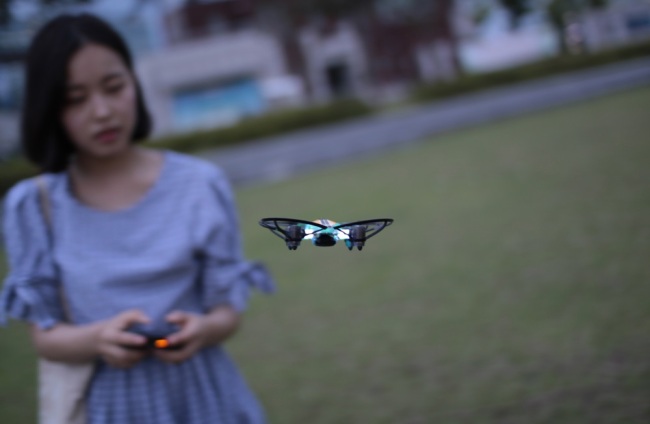 Corporations in South Korea froma wide variety of industry sectors are turning their eyes toward drone technology, which is expected to create a great number of new business opportunities down the road.
Corporations in South Korea froma wide variety of industry sectors are turning their eyes toward drone technology, which is expected to create a great number of new business opportunities down the road.
South Korea’s 10th-largest conglomerate, Hanwha, is one of those firms aiming to make headway into the unmanned aircraft industry.
The company, which has placed importance on the defense and military businesses since its foundation in 1952, recently acquired Samsung Techwin, the defense business arm of Samsung Group. The acquisition is said to be in line with Hanwha’s efforts to find a new cash cow in the defense and military sectors.
The acquisition will especially help Hanwha pick up the pace in developing unmanned aerial vehicles for a variety of applications, including military, agriculture and leisure.
Samsung Techwin has developed the Cube Copter, featuring four folding propellers and a surveillance camera, and is said to be planning to roll out two different heavy-load drones in October.
Hanwha chairman Kim Seung-youn has reportedly urged the conglomerate’s top executives and employees to grow the company’s defense businesses, including for drones, into “the upper echelons of the industries.”
Having worked together with university laboratories and small and medium-sized firms to develop drones, the company also plans to use unmanned aircraft in an annual fireworks event the conglomerate runs in Seoul.
Some market officials anticipate that more conglomerates will soon try to commercialize their own drones as the market draws more attention from the public and becomes more profitable.
“The drone industry will grow further as it proves to be profitable, attracting more participants including conglomerates and investment into the market,” said Jin Jung-hoi, chief executive of Xdrone, a Korean developer of drones.
Korea’s second- and third-largest mobile carriers KT and LG Uplus are trying to converge their telecommunications technologies with drones.
KT has recently started holding a contest where drone aficionados compete to accomplish missions, delivering relief goods to victims in simulated emergencies with drones that are partly made via 3-D printers.
A KT official said that “the event is part of the company’s plans to deploy drones fitted with network sensors in emergencies,” and that the mobile carrier would collaborate further with small- and medium- firms for drone technologies.
KT rival LG Uplus has been developing video solutions to process and transmit videos captured by cameras mounted on drones, utilizing Long Term Evolution networks.
LG Uplus has showcased how video solutions for drones can be used in real life by broadcasting an outdoor wedding live and video streaming simulated emergency situations, such as a breakdown of telecommunications networks.
The domestic drone market is seeing more small players jump on the wagon, targeting niche markets to avoid direct competition with cheap Chinese models.
Those small firms often receive positive market reactions, with their products featuring unique designs or functions and offering better after-sales service than Chinese firms.
Byrobot, a pioneer in the leisure drone market, produces a palm-sized quad-copter, named the Drone Fighter, installed with infrared sensors.
Users can fight drone battles with the quadrotor drones. The rules are simple: A user wins by shooting down other Drone Fighters by firing and hitting them with infrared signals six times.
Coupled with the rising population of “kidults,” ― grown-ups with a predilection for childish things ― the combat quadrotor helicopter has been drawing attention not only from teenagers, but also from those in their 20s and 30s.
The company said it ships 4,000-5,000 units per month in Korea.
“After releasing the Drone Fighter in 2013, X Drone has also been making forays into global markets, including Russia, Japan, the U.S. and the U.K., and has received positive reviews from those markets,” said James Hong, chief strategy officer of Byrobot.
Even though Chinese drone-makers, DJI in particular, dominate the global market for consumer drones, Korean drone developers said it is only a matter of time before they catch up.
“Since the world’s drone market is still in its infancy, the technological gap between leaders and the rest is not great. So Korean firms can readily catch up with those Chinese companies when there is enough investment,” Jin said.
Photo: Combat quadrotor helicopter Drone Fighter by Korean drone manufacturer Byrobot – Byrobot
Source: The Korea Herald
